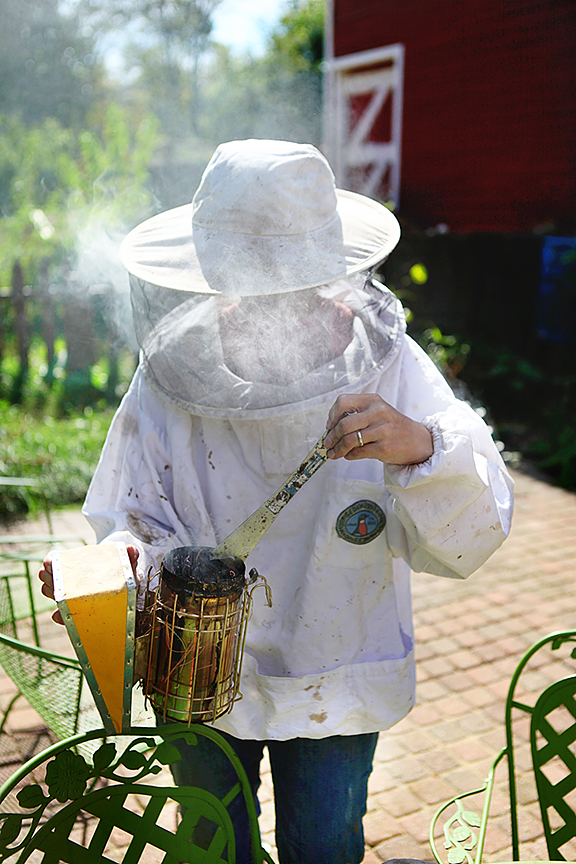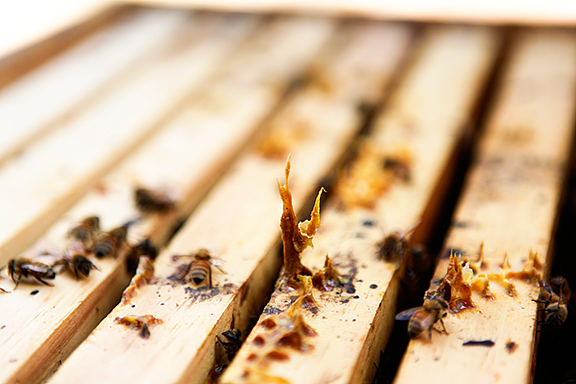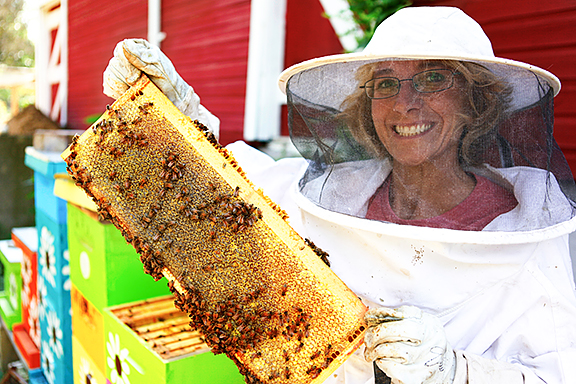By: Kelly VanderKley
My name is Kelly. I am a keeper of bees.
It all began for me a good couple of decades ago. I was in college and reading a required memoir from a random writer for a modern literature course I needed to take. The author lived alone in a remote mountain region and somewhere in her words there was a parallel between herself and the honeybees she fostered. In those words, I sunk until the winged little striped honey-makers were embedded deeply into my heart. As soon as I was able, I was subscribing to beekeeping magazines and reading anything I could find on the topic (this was long before the internet world). I read and studied for years upon years, always never feeling like I was in the right place with time, money and property to properly give a good home to honeybees of my own.
A fast forward to my world of today and I am proud as can be to finally call myself a beekeeper. I’m going on my 4th year officially keeping bees next spring – so I’m still new. Even with all of the reading and studying and devouring of information – and almost four years under my belt – I am still in my infancy stages of understanding them.
I worry about them. I miss them. I have nightmares about their demise. I keep game cameras on them to make sure predators like skunks aren’t lurking at night. I dig paths through the snow so I can listen to their winter mass “breathe” on days I can no longer see them. I photograph them. I watch them daily. Most conversations I have revolve around them at some point. I teach children about them when I can. I am a beekeeper.
On a recent weekend, I found myself missing the girls. The weather was a perfection of sun and mild temperatures with not a chance of rain. So, off I went to check on the girls. It was a day I did not need a bee suit (my photographer was in shorts standing right next to me). But, I did suit up and I did use the smoker a bit.
It was one of my last inspections for the year. So, the hives were full of ladies. The main goals of my inspection were: Find a queen or signs of a queen and check to see how much of a food supply they had collected in recent weeks.
So, I gently worked my way through the thick propolis (bee glue) they had constructed to close up all of the holes in their hive. They covered the entrances and glued them down with loads of the sticky substance. It is fascinating to think about this substance they make to hold their world together and keep it safe.
 Inside the hives I inspected, I did find very happy honeybees, all signs of a healthy queen, and loads of honey and pollen – so much in one hive that they were almost honey bound (filled to the gills with honey and no room for more).
Inside the hives I inspected, I did find very happy honeybees, all signs of a healthy queen, and loads of honey and pollen – so much in one hive that they were almost honey bound (filled to the gills with honey and no room for more).
To make space, I did pull a frame of honey. It is my plan going into this winter to leave them as much honey as possible in hopes that they can survive another long and brutal winter similar to the one we saw in Michigan last year. Winter preparations are in the near future, but for now, I am only checking up on them like the protective guardian I find myself to be.
 And tonight, I will be processing my small harvest for my winter – to use in tea and on toast and in teaspoons laced with cinnamon to hopefully help with the cold months ahead. (I use the crush and strain method of harvesting if you were wondering).
And tonight, I will be processing my small harvest for my winter – to use in tea and on toast and in teaspoons laced with cinnamon to hopefully help with the cold months ahead. (I use the crush and strain method of harvesting if you were wondering).
Hi Kelly
you appear to have only a few hives and are new to beekeeping. I have just about completed the building of two hives and the next step is to order the bees. I am a little concerned about the time commitment. How often do you need to inspect, or feed a hive?
I have read “The backyard BeeKeeper ” by Kim Flottum and he is very through in explaining all of the things that need to be done and can go wrong . But , I don’t get a good feel as to the frequency of visits and the amount of time required . any info. you can give me would be greatly appreciated.
Thanks
Dick